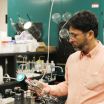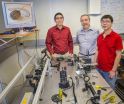(Press-News.org) Using next generation DNA sequencing, Dartmouth scientists have identified potentially actionable mutations in cancers of the appendix. Their study, "Molecular Profiling of Appendiceal Epithelial Tumors Using Massively Parallel Sequencing to Identify Somatic Mutations," was published in the journal Clinical Chemistry today. When specific mutations for a cancer type are identified, patients can be treated with chemotherapy or other targeted agents that work on those mutations.
Little is known about the molecular biology of two types of appendix tumors, low-grade appendiceal mucinous neoplasm (LAMN) and adenocarcinoma, but both can lead to pseudomyxoma peritonea (PMP), a critical condition in which cancerous cells grow uncontrollably along the wall of the abdomen and can crush digestive organs.
Dartmouth pathologists studied 38 specimens of LAMN and adenocarcinoma tumors (some of which had progressed to PMP) from their archives to look for shared genetic errors that might be responsible for the abnormal cell growth. Tissue samples were sequenced using the AmpiSeq Hotspot Cancer Panel v2, which pathologists had verified for the clinical screening of mutations in 50 common cancer-related genes for which treatments exist. This was the first study making use of a multigene panel in appendiceal cancers to support the use of potential targeted therapies.
"We routinely use this molecular profiling approach on all of our lung adenocarcinomas, melanomas, colon cancers, and gliomas," said Gregory Tsongalis, PhD, principal investigator for the study and director of Molecular Pathology at Dartmouth-Hitchcock Norris Cotton Cancer Center. He says examining an individual tumor profile has the potential to significantly alter patient outcome in a positive way.
KRAS and GNAS mutations were the most common alterations identified in the study. Twelve distinct abnormalities were mapped to the KRAS gene. Additional mutations were identified (i.e., AKT1, APC, JAK3, MET, PIK3CA, RB1, and STK11 for LAMN and TP53, GNAS, and RB1 for adenocarcinoma) in the four sample types studied. Seven of these mutations were shared by more than one group, which suggests there is some molecular similarity.
"These findings suggest that tumors of the appendix, although rare and very aggressive, are distinct entities and have subclasses of disease within each category that are different from each other based on their mutation profile," said Tsongalis. "New therapeutic approaches may be able to target those pathways that are mutated in these tumor types."
This laboratory research has the potential to change clinical practice if physicians now develop treatment plans to target the identified genetic mutations. "Our success in the Dartmouth-Hitchcock Medical Center Department of Pathology at the Norris Cotton Cancer Center is attributed to our multidisciplinary approach to these discoveries, which truly allow us to bring scientific findings from the bench to the bedside," said Tsongalis.
INFORMATION:
About Norris Cotton Cancer Center at Dartmouth-Hitchcock
Norris Cotton Cancer Center combines advanced cancer research at Dartmouth and the Geisel School of Medicine with patient-centered cancer care provided at Dartmouth-Hitchcock Medical Center, at Dartmouth-Hitchcock regional locations in Manchester, Nashua, and Keene, NH, and St. Johnsbury, VT, and at 12 partner hospitals throughout New Hampshire and Vermont. It is one of 41 centers nationwide to earn the National Cancer Institute's "Comprehensive Cancer Center" designation. Learn more about Norris Cotton Cancer Center research, programs, and clinical trials online at cancer.dartmouth.edu.
Dartmouth scientists identify genetic blueprint for cancerous tumors of the appendix
2014-05-12
ELSE PRESS RELEASES FROM THIS DATE:
Ames Lab creates multifunctional nanoparticles for cheaper, cleaner biofuel
2014-05-12
The U.S. Department of Energy's Ames Laboratory has created a faster, cleaner biofuel refining technology that not only combines processes, it uses widely available materials to reduce costs.
Ames Laboratory scientists have developed a nanoparticle that is able to perform two processing functions at once for the production of green diesel, an alternative fuel created from the hydrogenation of oils from renewable feedstocks like algae.
The method is a departure from the established process of producing biodiesel, which is accomplished by reacting fats and oils with alcohols.
"Conventionally, ...
Mount Sinai researchers identify changes that may occur in neural circuits due to addiction
2014-05-12
A research team from the Friedman Brain Institute of the Icahn School of Medicine at Mount Sinai has published evidence that shows that subtle changes of inhibitory signaling in the reward pathway can change how animals respond to drugs such as cocaine. This is the first study to demonstrate the critical links between the levels of the trafficking protein, the potassium channels' effect on neuronal activity and a mouse's response to cocaine. Results from the study are published in the peer-reviewed journal Neuron on May 7, 2014.
The authors investigated the role of ...
Corn dwarfed by temperature dip suitable for growing in mines, caves
2014-05-12
WEST LAFAYETTE, Ind. - Lowering temperatures for two hours each day reduces the height of corn without affecting its seed yield, a Purdue study shows, a technique that could be used to grow crops in controlled-environment facilities in caves and former mines.
Raising the crops in isolated and enclosed environments would help prevent genetically modified pollen and seed from escaping into the ecosystem and crossing with wild plants.
Cary Mitchell, professor of horticulture, said the technique could be particularly useful for growing transgenic crops to produce high-value ...
INFORMS study: Online buzz forecasts new product performance months before product release
2014-05-12
Companies can significantly improve the forecasting accuracy of forthcoming products' performance by mining online consumer buzz prior to product release, according to a study being published by Marketing Science, a journal of the Institute for Operations Research and the Management Sciences (INFORMS).
Social media attention to a firm's forthcoming products also influences its stock price, the study shows.
Pre-Release Buzz Evolution Patterns and New Product Performance is by Guiyang Xiong and Sundar Bharadwaj, professors at Terry College of Business at the University ...
Potential cure for captive amphibians with chytrid fungus
2014-05-12
Researchers at Vanderbilt University have identified an alternative to a sometimes toxic therapy that protects frogs in zoos from a deadly fungal infection that has been destroying the amphibian populations worldwide. Their research is published ahead of print in Applied and Environmental Microbiology.
The fungal disease, chytridiomycosis, has been decimating frogs all over the world. At present, nothing can help amphibians in the wild, but zoos currently rely on the often-toxic itraconazole to eradicate the disease from infected amphibians they wish to acquire.
To ...
UBC scientists find new way to mobilize immune system against viruses
2014-05-12
University of British Columbia scientists have uncovered an intricate chain reaction in the body's immune system and have used the knowledge to develop a new treatment against harmful viruses.
Viral pandemics, such as the coronavirus that caused the deadly SARS outbreak in 2002, have caused hundreds of deaths in Canada, yet effective anti-viral drugs are rare.
A key element to this natural immune response is an antiviral protein in the blood called Interferon alpha. Like soldiers, Interferon alpha is quickly deployed by the body to fight viruses and removed just as ...
Alcohol and drugs: Not just for modern man
2014-05-12
Unlike modern Man, the prehistoric people of Europe did not use mind-altering substances simply for their hedonistic pleasure. The use of alcohol and plant drugs – such as opium poppies and hallucinogenic mushrooms – was highly regulated and went hand-in-hand with the belief system and sacred burial rituals of many preindustrial societies. Elisa Guerra-Doce of the Universidad de Valladolid in Spain contends that their use was an integral part of prehistoric beliefs, and that these substances were believed to aid in communication with the spiritual world. Guerra-Doce's research ...
All in the rotation
2014-05-12
Viruses are the enigma of the biological world – despite having their own DNA and being able to adapt to their environment and evolve, they are not considered to be alive like cells. In order to reproduce and multiply – a requirement of "life" - a virus must invade a living cell, eject its DNA into that of the cell, and commandeer the cell's biological machinery. While a virus, essentially, may be nothing more than a dollop of DNA packed into a protective coating of protein called a capsid, the packaging of that DNA is critical. The molecular motors that drive this DNA ...
Video stories, other bonding exercises could help foster families connect
2014-05-12
Teenagers and their foster families often say they don't feel connected and have trouble communicating, but few resources exist that nurture their bonding. In a research paper being published in the June issue of Children and Youth Services Review, researchers affiliated with the University of Washington's School of Social Work describe how they tailored a parenting program known to improve communication in non-foster families for use in foster families.
"Every family has its own unique dynamics, such as different rules or expectations. When teens are placed into a foster ...
Two genes together drive aggressive prostate cancer
2014-05-12
NEW YORK, NY (May 12, 2014) —Two genes work together to drive the most lethal forms of prostate cancer, according to new research from the Herbert Irving Comprehensive Cancer Center at Columbia University Medical Center (CUMC). These findings could lead to a diagnostic test for identifying those tumors likely to become aggressive and to the development of novel combination therapy for the disease.
The two genes—FOXM1 and CENPF—had been previously implicated in cancer, but none of the prior studies suggested that they might work synergistically to cause the most aggressive ...


